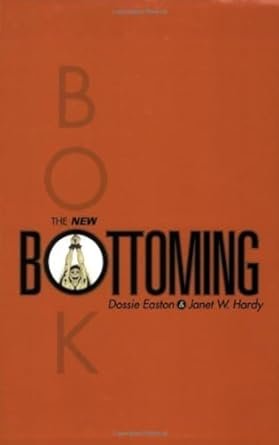Introduction to the New Bottoming Book
The “New Bottoming Book,” authored by Dossie Easton, emerges as an essential resource for individuals interested in exploring BDSM and the diverse dynamics of consensual sexual practices. This updated edition builds upon the foundational ideas laid out in the original “Bottoming Book,” released nearly two decades ago, and it seeks to enhance the reader’s understanding of what it means to be a bottom within the context of BDSM relationships. Easton, a renowned therapist and educator in the realm of alternative sexuality, brings her extensive knowledge and experience to the forefront, ensuring that the readers are provided with a comprehensive perspective on the emotional, physical, and psychological dimensions of bottoming.
Easton’s motivation to write this book stems from her passion for creating safe spaces where individuals can explore their desires without fear or shame. She emphasizes the importance of informed consent, communication, and safety measures within BDSM practices. In a world where misconceptions about BDSM often malign the lifestyles of those who practice it, this book serves as a guiding light, validating the experiences of bottoms while also advocating for healthy interactions between partners.
Through a well-structured approach, “New Bottoming Book” delves into critical topics such as overcoming fears related to submission, establishing trust, and navigating the complex emotions that can arise from BDSM activities. It provides readers with practical advice and insights aimed at fostering personal growth and understanding in their intimate relationships. By addressing the dynamics of bottoming in a respectful and comprehensive manner, the author allows practitioners to approach their experiences with confidence and a sense of empowerment.

In the early 1990s, the first Bottoming Book taught tens of thousands of people that bottoming — being a submissive, masochist, slave, ‘boy’ or ‘girl, ‘ or other BDSM recipient — is as much an art as topping. Since then, the growing popularity of BDSM, and the blossoming of the Internet as a source of information and connection, have created a whole new universe of possibilities for players. Now, the completely updated revised New Bottoming Book gives even more insights and ideas about how to be a successful, popular bottom!
Key Concepts and Themes
The New Bottoming Book by Dossie Easton delves into several core concepts that form the foundation of understanding bottoming within the framework of BDSM. One of the primary themes explored is the emotional and psychological dimensions of bottoming. The book emphasizes that the experience of being a bottom is not solely physical; it intertwines emotional nuances that influence how individuals engage in power exchange. The narrative encourages readers to explore their feelings and motivations behind their choice to bottom, fostering a deeper self-understanding.
Another significant theme in the book is the importance of communication between partners. Easton aptly highlights that effective communication is critical to navigating the complexities of BDSM dynamics. The text introduces tools and strategies for ensuring that both partners feel heard and respected. It discusses how establishing clear lines of dialogue can lead to more fulfilling and safe experiences, emphasizing that dialogue extends beyond initial negotiations, evolving as trust develops.
Consent is a predominant pillar in the landscape of BDSM relationships that Easton addresses with clarity. The New Bottoming Book reiterates that informed consent is essential in establishing a safe and enjoyable experience for all parties involved. The author discusses the nuances of obtaining consent, offering insight into continuous consent practices, where partners check in with each other throughout their interactions. This vigilant approach ensures that boundaries are respected and allows for an adaptive and responsive relationship dynamic.
Furthermore, safety practices are critically outlined, with Easton providing guidance on how to create a safe environment for bottoming. This includes establishing safe words, understanding physical limitations, and the importance of aftercare. Collectively, these themes highlight not only the complexity of bottoming but also the elements of trust and mutual respect that underpin healthy BDSM engagements.
Practical Tips and Techniques
In “The New Bottoming Book,” Dossie Easton provides a wealth of practical advice and techniques aimed at those interested in exploring the dynamics of bottoming. Preparation is a vital aspect highlighted in the book, as it allows individuals to understand their own limits, desires, and boundaries before engaging in any activity. Easton encourages readers to create a safe environment where they can freely express their needs and preferences. This preparation phase may involve considering factors such as consent, comfort levels, and physical or emotional readiness.
Another critical element discussed is aftercare, which Easton emphasizes as essential for both emotional and physical well-being post-experience. Engaging in aftercare can significantly enhance the overall experience and foster deeper connections between partners. This may include experiencing intimacy through cuddling, discussing the experience or feelings, and attending to any physical needs that may arise following the session. It is crucial to recognize that aftercare is not merely a checklist but a personalized process tailored to the unique needs of each individual.
Negotiation of boundaries is another essential skill discussed in the text. Easton stresses the importance of clear and open conversations about what is acceptable and what is not. This can involve discussing limits, triggers, and safe words prior to engaging in any activities to ensure that mutual understanding and consent are maintained throughout the experience. This ensures that all parties involved feel secure and appreciated, ultimately contributing to a more positive experience for everyone.
Lastly, the book offers various bottoming techniques that cater to different preferences and experiences. By experimenting with these techniques, readers are encouraged to discover what brings them joy and satisfaction, which can lead to a more fulfilling bottoming experience. Overall, the practical tips and techniques outlined in “The New Bottoming Book” serve as a comprehensive guide for individuals looking to enhance their practices safely and enjoyably.
Community Impact and Reception
The release of the New Bottoming Book by Dossie Easton has generated considerable discussion within the BDSM community and beyond. Early readers have provided feedback highlighting its nuanced exploration of bottoming and consent, which has long been a subject of interest in sexual relationships. This comprehensive guide serves not only as an instructional manual but also as a critical resource that addresses the dynamics of power exchange, communication, and safety in consensual BDSM practices.
Expert opinions on the book reinforce the value of Easton’s insights. Many practitioners and educators within the BDSM community praise the work for destigmatizing bottoming, a topic often overshadowed by misconceptions and societal taboos. By providing a clear framework for understanding the role of bottoms, Easton contributes significantly to the discourse surrounding empowerment in sexual encounters. The book encourages open dialogue, allowing readers to navigate the complex emotions and considerations involved in engaging with bottoming through a lens of agency and informed consent.
Moreover, the New Bottoming Book plays a pivotal role in ongoing discussions about sexual health. It emphasizes the importance of safety measures and informed consent, which are foundational to healthy BDSM practices. This focus aligns with contemporary conversations about sexual empowerment, making it relevant not only to BDSM practitioners but also to a broader audience seeking to understand various facets of sexual relationships. By presenting bottoming as a legitimate and valuable experience, Easton’s work fosters an inclusive atmosphere that empowers individuals to explore their desires and boundaries confidently.
Overall, the reception of the New Bottoming Book signifies a shift towards acknowledging the diverse experiences within the BDSM community, helping foster a greater understanding of the intricacies of bottoming and consent.







